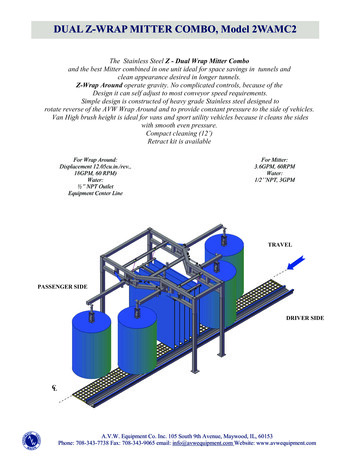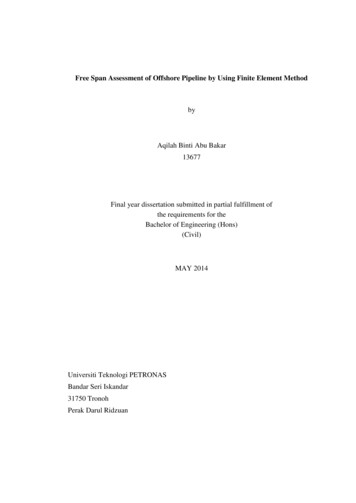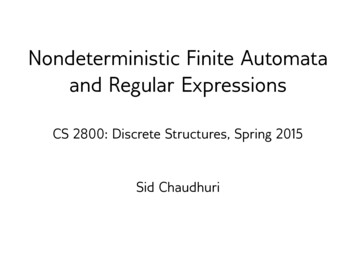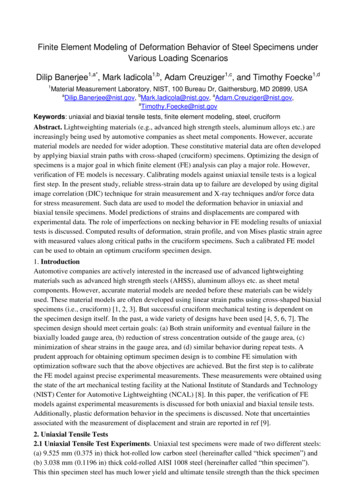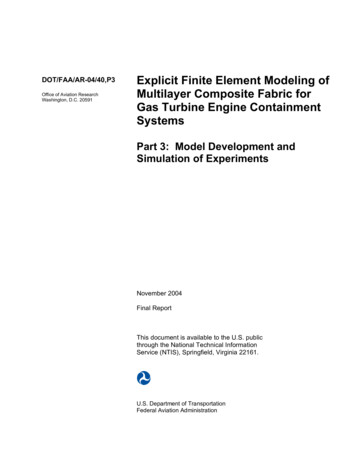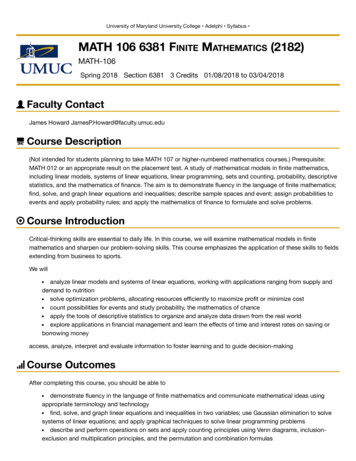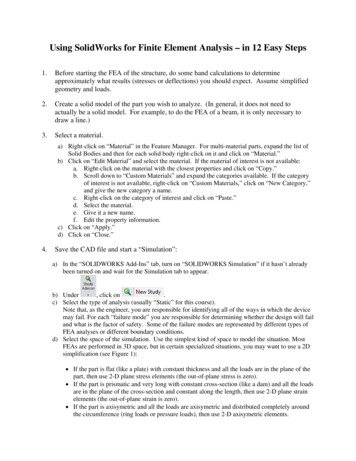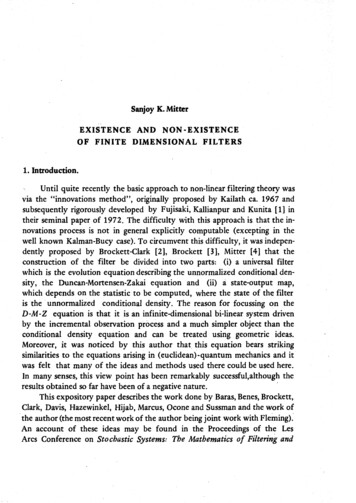
Transcription
Sanjoy K. MitterEXISTENCE AND NON-EXISTENCEOF FINITE DIMENSIONAL FILTERS1. Introduction.Until quite recently the basic approach to non-linear filtering theory wasvia the "innovations method", originally proposed by Kailath ca. 1967 andsubsequently rigorously developed by Fujisaki, Kallianpur and Kunita [1] intheir seminai paper of 1972. The difficulty with this approach is that the innovations process is not in general explicitly computable (excepting in thewell known Kalman-Bucy case). To circumvent this difficulty, it was independently proposed by Brockett-Clark [2], Brockett [3], Mitter [4] that theconstruction of the filter be divided into two parts: (i) a universal filterwhich is the evolution equation describing the unnormalized conditional density, the Duncan-Mortensen-Zakai equation and (ii) a state-output map,which depends on the statistic to be computed, where the state of the filteris the unnormalized conditional density. The reason for focussing on theD-M-Z equation is that it is an infinite-dimensional bi-linear system drivenby the incrementai observation process and a much simpler object than theconditional density equation and can be treated using geometrie ideas.Moreover, it was noticed by this author that this equation bears strikingsimilarities to the equations arising in (euclidean)- quantum mechanics and itwas felt that many of the ideas and methods used there could be used here.In many senses, this view point has been remarkably successful,although theresults obtained so far have been of a negative nature.This expository paper describes the work done by Baras, Benes, Brockett,Clark, Davis, Hazewinkel, Hijab, Marcus, Ocone and Sussman and the work ofthe author (the most recent work of the author being joint work with Fleming).An account of these ideas may be found in the Proceedings of the LesArcs Conference on Stochastic Systems: The Mathematics of Filtering and
174Identification eds. M. Hazewinkel and J.C. Willems, D. Reidei Pubi. Company,1981 and in as yet unpublished work of the author. The programme outliningthis approach can be found in the work of Brockett [2], [3] and in theauthor's paper [5]. See also the doctoral dissertation of D. Ocone [6], writtenunder this author's direction.2. The Filtering Problem Considered, and the Basic Questions.We consider the signal-observation model:(2.1)dxt f(xt)dt G(xt)dwtdyt h(xt)dt dt\t ,; x(0) —x0where0 t lx,w and y are lRw,IRm and R -valued processes, and it is assumed thatf,G and h are vector-valued, matrix-valued and vector-valued functionswhich are smooth (which mean C -functions). It is further assumed that thestochastic differential equation (1) has a global solution in the sense of Ito.It is also assumed that xt and r\t are independent and E I \h(xt)\2dt x.For most of our considerations, the function h( ) will be a polynomial.It is now well known that the unnormalized conditional density p(t,x)(where we have suppressed the y (#) and co-dependence) satisfies the D-M-Zequation:(2.2) dp(t,x) [ * - \ì hì(x))p(t,x)dt I hi(x)p(t,x)odyt,where(2 3)-fM *- jL - w w v - k é; *and the o denotes Stratonvich differential. It is imperative that we consider(2.2) as a Stratonvich differential equation, since the Ito-integral, becauseit "points to the future", is not invariant under smooth diffemorphisms of thetf-space, and we want to study equation (2.2) in an "invariant manner".We think of p(t, ) as the "state" of the filter and is, what we havereferred to before, as the universal part of the filter. If p, say, is a bounded,continuous function than the filter typically is required to computeE(*(Xt)\Fyt\ where a\ys, 0 s t ] . If we denote by fa E( p(Xt)&yt\then \pt is obtained from p(ttx) by integration:o
175(2.4){pt I\p{x)p(ttx)dx/l*p(t,x)dx\pt will be referred to as a "conditional statistic", and no matter what (pt wewish to compute, p(t,x) serves as a "sufficient statistic". One of the questions we want to try to answer in this paper is: when can !pt (corresponding to a given p) be computed via a finite-dimensiónal filter? The otherremark to be made is: we are interested in computing the fundamental solution of (2.2) so that we can evaluate p(ttx) corresponding to any initial condition.To proceed further we need to make a definition. By a finite-dimensionalfilter for a conditional stochastic tpt, we mean a stochastic dynamical systemdriven by the observations:(2.5)dtt *(tt)dt fi(tt)odytdefined on a finite-dimensional manifold Af, so that %t EAf and oi(%t) andP( t) are smooth vector fields on Mt together with a smooth output map(2.6)& 7(fe) ,which computes the conditional statistic. Equation (2.5) isto be interpreted inthe Stratanovich sense for reasons we have mentioned above. We shall alsoassume that the stochastic dynamical system (2.5)-(2.6) is minimal in the senseof Sussmann (cf. later section).3. Preliminaries. (On Lie Algebras, Lie Groups and Representations).For most of this paper, the C -manifold we will be interested in is IRW(which is covered by a single coordinate system).We shall say that a vector space ove R is a redi Lie algebra,if in addition to its vector space structure it posseses a productJC X —* : (X, Y) —* [X, Y] which has the following properties:(i) it is bilinear over IR(ii) it is skew commutative: [X, Y] [Y,X] 0 (iii) it satisfies the Jacobi identity:\ VX, YtZE [Xt [Y,Z]] [Y, [Z,X]] [Z, [Xf Y]] 0.
176Example: Jtn(IR) algebra of 'nXn matricesover IR.If we denote by [X, Y] XY — YX, where XY is the usuai matrix product, then this commutator defines a Lie algebra structure on „(!R). Example: Let SC(M) denote the C -vector fields on a C-manifold M. (M) is a vector space over IR and a C (M) module. (Recali, a vector fieldX on M is a mapping: M—*Tp(M)'-p \- Xp where pEM and Tp(M) isthe tangent space to the point p at M). We can give a Lie algebra structureto 3C(M) by defining:Zpf (XY-YX)pf Xp(Yf)-Yp(Xf),feC (p)(the C -functions in a neighbourhood of p), and [X, Y] X y — VX. Both these examples will be useful to us later on.Let X be a Lie algebra over IR and let {Xlt. ,Xn) be a basis of X(as a vector space). There are uniquely determined constants crsp G IR( l r , 5 , p « ) suchthat[Xr ,XS] 2cfSp XpThe cr5p are called the structure constants of relative to the basis{Xx ,.,X„}. From thè definition of a Lie algebra:(i) crsp csrp 0(iì)S1 ; M(Kr,s,p n)(CrSpCptu CsjpCpm CtrpCpsu) 0( 1 r,5, t , « » ) . Let be a Lie algebra over IR. Given two linear subspaces M , Jf ofX, we denote by [ , ] the linear space spanned by [X, Y), X G J andYE.Jf. A linear subspace JT of X is called a sub-algebra if [Jfjf] C JT, axìidealìf [Xjf] j f .If JC and X' are Lie algebras over IR and 7r : X — X* : X i— 7r(X), alinear map, 7r is called a homomorphism if it preserves brackets:[7r(X),7r(y)] 7r([X,y])(X,KGX).In that case 7r(X) is a subalgebra of X' and ker 7r is an ideal in X.Conversely let X be a Lie algebra over IR and JT an &fea/ of X. Let ' X/tf be the quotient vector space and ir : X —* the canonical linearmap. For X9 TT(X) and Y* ?r(y), let[ y] f(Rn).
177This mapping is well defined and makes ' a Lie algebra over R and ir isthen a homomorphism of into ' with Jf as the kernel. JC' /K iscalled the quotient of JC by JC.Let % be any algebra over R, whose multiplication is bilinear but notnecessarily associative. An endomorphism D of tyl (considered as a vectorspace) is called a derivation ifD(*fc) (Da)fc a(Dfc)a,be %If Di and D2 are derivations so is [Di,D2] DiD2.— D2Di. Theset of ali derivations on U (assumed finite dimensionai) is a subalgebra ofgl( l)y the Lie algebra of ali endomorphisms of % . For us the notion of a representation of a Lie algebra is very important.Let be a Lie algebra over R and V a vector space over R, notnecessarily finite dimensionai. By a representation of JC in V we mean a mapir : X i— 7r(X) : —-* g/(K)(ali endomorphisms of V)such that(i) 7r is linear(ii) w([X,Y]) ir(X)ir(Y)-Tt(Y)ir(X).mFor any X G , let ad X denote the endomorphism of adX:y*-* [X,K](K JC).ad X is a derivation of JC and Xt- adA' isa representation of in X, called the adjoint representation. Let G be a topological group and at the same time a differentiablemanifold. G is a Lie group if the mapping (x,y) i—* xy : G X G j—* G andthe mapping * i— a;"1 : G — G are both C -mappings.Given a Lie group G there is an essentially unique way to define its Liealgebra. Conversely every finite-dimensional Lie algebra is the Lie algebra ofsome simply connected Lie group. In filtering theory some special Lie algebras seem to arise. We give thebasic definitions for three such Lie algebras.A Lie algebra over R is said to be nilpotent if ad X is a nilpotentendomorphism of , VX G . Let the dimension of JC be m. Then thereare ideals fi of such that
178(i) dim J j — m —j , 0 /' m(ii) o D «/, D . Djm -0and(in) [ ,Sj]CJj l,0 j m-l.Let g be a Lie algebra of finite-dimension over IR and write g Igfgl g is a sub-algebra of g called the derived algebra. Define p g(p 0) inductively by9 g 9W'lg)(p l).We then get a sequence @ gD S)lg L. of sub-algebras of g. g is saidto be so Iva b le if S*g 0 for some p 1.Examples(i) Let n 0 and let (pj,., p„, qx,., q„, z) be a basis for a real vectorspace Y . Define a Lie algebra structure on 'V by [pi,qi] l4i piì 2, the other brackets being zero. This nilpotent Lie algebraJf is the so-called Heisenberg algebra.(ii) The real Lie algebra with basis (h, pt,.,the bracket relations[ / ,] ?, [h,4i] Pi,pn, qx,., qn, z)satisfying[pi, i] 2 ,the other brackets being zero is a solvable Lie algebra, the so-called oscillator algebra. Its derived algebra is the Heisenberg algebra jV. A Lie algebra is called simple if it has no: non-trivial ideals.An infinite dimensionai Lie algebra is called profinite dimensionaiand filtered if there exists a sequence of ideals J x D f2 — such /Ji isfinite-dimensional for ali i and O [0\.3.1-Infinite-DimensionalRepresentations.Let g be a finite dimensionai Lie algebra and G its associated simplyconnected Lie group. Let H bea complex Hilbert space (generally infinite-dimensional). We are interested in representations of g by means of linearoperators on H with a common dense invariant domain @. Let ir denotethis representation.Similarly we are also interested in representations of G as bounded
179linear operators on3ff— L(H) satisfies. Let r be such a representation. That is, T: G — r(gig2) r(g\)r(gi) gugi G.The following problem of Group representation has been considered byNelson [7] and othérs. Given a representation ir of g on H when does thereexist a group representation (strongly continuous) r of G on H such thatr(exp (tX)) exp (t ir(X))VXGG .Here exp( 7r(X)) in the strongly continuous group generated by ir(X) inthe sense thatd — exp(t7r(X)) 7T(X)(pK p and exp (tX) is the exponential mapping mapping the Lie algebra g into theLie group G.Let Xlf., Xd be a basis for g. A method for constructing r locallyis to definer(exp(t 1 X 1 ) . exp(tdXd)) exp jTrfXi)) . exp( 7r(X )).A sufficient condition for this to work is that the operator identity(3.1)exp(Mf-)-A,- 2 — [ad Aj]nAt;exp(M.-)holds for y 7r(X;) , 1 / , ; d.It is a well known fact, that many Lie algebra representations do notextend to Group representations. An example is the representation of theHeisenberg algebra consisting of three basis elements by the operatorsj — ix, -j—, — i on L2(IR ) with domain Cj lR,.) which does not extendto a unitary representation (since essential self-adjointness fails).Although in fittering theory we are not interested in unitary grouprepresentations, nevertheless these ideas will serve as a guide for integratingthe Lie algebras arising in filtering theory.
1804. Lie Algebra of Operators Associated with the Filtering Problem.Consider the unbounded operatorsje j e j - y . bfa)and hi(x) ,ì l,.fpfwhere the operators bj(x) are considered as multiplication operators*P(x)* .bj(x)'ip(x)t and and ib,- are defined on some common denseinvariant domain (say CQ(IRW) or I R " ) ) .The Lie algebra of differential operators SF generated by andhlt. ,hp is called the filter algebra.This Lie algebra contains important information and if it is finite-dimensional then it is a guide that a finite dimensionai universa! filter for computing p(t,x) may exist (it is not being said that if this Lie algebra is infinite-dimensional that no finite-dimensional filter exists).Therefore the first question that arises is: are there examples of non-linear filtering problems with finite dimensionai filter algebras? The secondquestion is:How large is this class? The answer to the first question is — yes —, butthe answer to the second question appears to be is that this class is small.Example 1 (Kalman Filtering)dxt Axtdt bdwt ifdyt c'xtdt drit(4.1)A nXn matrixb n X 1 matrixc « X l matrixTheni»2 i,/-i(42)a2n aóXióXj'1 1 óXj 0 X; - y (c' ) 2 , whereDefine the Hamiltonian matrixE t -A'—/ibb and the vectorcece%
1811 R2wa Iand the controllability matrixW [a'-Ea:.\E2n lCL\and assume that W is non-singular.Define Zx c'x andZ fadjCor Zi .Then one can show that(4.3)Z . S a . i a - i - ,and(4.4)" 7 j (E a) .[Z„ Zj] (iT'a)' rWe can then conclude that the filter algebra 3F span{jC0, Zlf., Z2n,/ } , where the Zl,.,Z2nare independent by hypothesis. Hence & hasdimension 2w 2 and this algebra is isomorphic to the oscillator algebra ofdimension 2» 2.4.1 - Invariance Properties ofthe Lie Algebra and the Benes Problem.The filter algebra is invariant under certain transformations, namelydiffeomorphisms of the #-space and gauge transformations to be discussedbelow. These ideas are best discussed on an example.Consider the filtering problem:((4.5)xt wt( dyt xtdtA basis for the filter algebra x1 d21J
If we denot bey [X,Y] XY — YX, wher XYe is the usuai matrix pro-duct, then this commutator define as Lie algebra structure o n „(!R) . Example: Le SC(M)t denot the C -vectoe r o fieldn a C-manifols M. d (M) is vecto a r space ove IrR and a C (M) module. (Recali, a vector field X on M is mapping a : M—p*T(M)'- \- Xp p wher pEMe anpd(M) T is the tangent spac toe th e point p .
